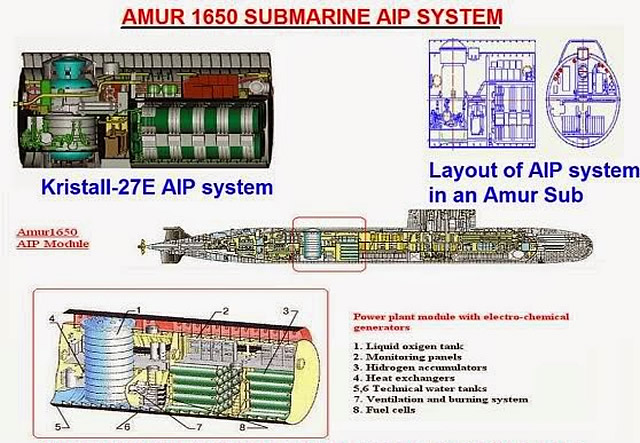 AIP
sytem on the AMUR class submarine (for illustration purpose only) AIP
sytem on the AMUR class submarine (for illustration purpose only) |
|||
According
to Landgraf, the Russian Industry and Trade Ministry is considering Rubin
and Krylov’s proposal for the Development of an AIP Plant Prototype
and an Associated Floating Test Bench development work. The proposal had
resulted from a resolution by the September 12, 2015 governmental meeting
chaired by Deputy Prime Minister Dmitry Rogozin. The proposal was approved
by the Russian Navy’s leading research institute. The work is designed
for four years from 2016. Given the scale and urgency of the task assigned,
the financing requested under the program totals several billion rubles. "We are waiting for the proposal to be approved and the financing hashed out," the deputy director said, "and the Russian Industry and Trade Ministry was tasked with getting the money to pay for the program. Therefore, I think it will take place." Rubin, which completed the research into the land-based AIP plant prototype in December 2014, will be prime contractor, while Krylov’s TsNII SET affiliate is to develop, manufacture and supply an electrochemical generator with a capacity of several hundred kilowatt for the in-development AIP plant prototype, with the generator to "consist of polyethylene fuel cell-based stacks with a unit power of 50kW." The prototype of the afore-said BTE-50K fuel cell-based stack was designed, made, tested and submitted to the customer, the Russian Industry and Trade Ministry, under the Krylov-performed AIP Plant with Oxidation Product Disposal development work in 2011-2015. The acceptance trials of the BTE-50K - the most effective Russian-made fuel cell-based stack - were completed with success in March 2015, and the customer accepted the example. To display Krylov’s progress in hydrogen power generation and fuel cells, a BTE-50K analog designed for commercial applications was exhibited at several shows and got good press," Landgraf said. "Now, Rubin and we have a clear-eyed understanding of the way to follow to develop a highly effective AIP plant as soon as possible," the chief designer stressed. "We also realize that advanced diesel-electric submarines are plain inconceivable unless equipped with AIP plants. AIP plants are needed both by the Russian Navy and the navies of many countries, with which we maintain partnership relations and that are our potential customers." According to Landgraf’s estimates, if the financing starts in 2016, the AIP plant’s test on the floating test bench will start in 2018 at the earliest. Krylov’s Executive Director Mikhail Zagorodnikov, in turn, said the lack of AIP plants onboard Russian diesel-electric submarines might deny them demand on the global naval arms market. "China and the Republic of Korea build diesel-electric AIP submarines. India is beginning to make [such] boats of its own in cooperation with the French. We will miss the market, unless we develop an AIP plant," Zagorodnikov stressed. © Copyright 2015 TASS. All rights reserved. This material may not be published, broadcast, rewritten or redistributed. |
|||
Russia Developing New Fuel-Cell Air Independent Propulsion System for Submarines - TASS
- Posted On










